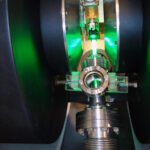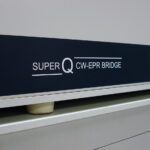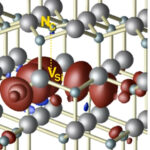Team
- Permanent members: Jean-Louis Cantin, Ian Vickridge, Emrick Briand
- Researcher Emeritus: Jurgen Von Bardeleben
Identification of defects in wide band gap semiconductors
In order to contribute to the removal of technological barriers in the microelectronics industry, we seek to identify defects in various large band gap semiconductors of technological importance for optoelectronics, power electronics and photovoltaics, such as SiC, GaN or more recently Ga2O3. Point defects generate electronic states in the band gap. They therefore condition the electrical and optical properties of these materials and consequently the functioning of the components. Silicon carbide SiC in particular is a material of choice for the realization of components for power and high frequency electronics. Thanks to the advances made in the knowledge of its crystal growth and its defects, this semiconductor is used today in the power supplies of electric motors such as those of hybrid cars, subways, and air conditioning compressors. The gain in efficiency compared to the previous technology allows a reduction in electrical consumption of 30 to 40%. Numerous research projects are underway to optimize the performance and extend the range of applications of this semiconductor. Our research exploits electron magnetic resonance to identify and quantify the defects present in these materials, through their electron spin. We take advantage of the team’s ion gas pedal to study defects induced by irradiation, in order to amplify the concentration of defects for analysis or to understand the behavior of components subjected to ionizing radiation.

Caption: Photo-EPR: in situ optical excitation to reveal defects. © INSP
Control of induced magnetism in semiconductors
Our research also focuses on the magnetic properties induced artificially in naturally non-magnetic semiconductors. This magnetism can be induced by doping with magnetic ions. We then obtain ‘diluted magnetic semiconductors’ (DMS), which are interesting for spin electronics because their photo-, electro-, or mechano-modulable physical properties constitute a major asset for magnetization control. We have studied the origin of ferromagnetism in Mn-doped GaAs, which is a DMS with a Curie temperature around 180K. We focused on the influence of carrier concentration and stress on the magnetic anisotropy of GaMnAs films. This work has been extended to GaMnAsP quaternary alloys whose stress state can be controlled by the phosphorus content. We were able to determine the optimal conditions for manipulating the magnetization of this alloy and obtained two consecutive ANR funding. We then showed that the uniaxial magnetic anisotropy of GaMnAsP is modified after ion bombardment with helium ions, e.g. it is possible to induce a rotation of the easy magnetization axis from the [001] direction out of the plane of the film to the [100] direction in the plane.
In parallel, several collaborations with chemists of the Inst. Parisien de Chimie Moléculaire have led to an extension of our studies towards optically or chemically switchable magnetic molecular systems, some of them being grafted onto semiconductor surfaces or nanoparticles. This work has been funded by three ANR projects.

Caption: Multi-frequency approach for the determination of magnetic relaxation. © INSP
Study of point defects for quantum information technologies
For the past five years, we have been studying the optomagnetic properties of point defects in silicon carbide with the goal of using them as quantum bits for future quantum computing. In 2015, we identified in particular a defect, called NV center and formed by a nitrogen atom (impurity of SiC) and a silicon gap, which has an electron spin S=1 like the NV center of diamond, which has been very much studied for the last decade for this same application, but which suffers from limited opportunities due to the cost of diamond and difficulties in doping it, especially of p-type. These two difficulties are overcome by SiC, now massively used and controlled by the microelectronics industry. Electron spin resonance experiments under optical photo excitation have allowed to determine the magneto optical signature of the NV centers on the different crystallographic sites of the 6H, 4H and 3C polytypes of SiC. The studies of the optical properties of the NV center in SiC are currently in progress in order to realize the optical detection of the magnetic resonance (ODMR) and to establish the possibility of the optical manipulation of its electronic spin. These studies are pursued at INSP through a collaboration with S. Hameau and B. Eble of the PMTeq team and simultaneously in partnership with W. Gao’s team from Nanyang Technological University (NTU Singapore) in the framework of a collaboration initiated thanks to a Hubert Curien project (PHC Merlion) obtained in late 2016.

Légende :
Collaborations
- W. Gao – Nanyang Technological University (NTU Singapore)
- U. Gertsmann, Univ of Paderborn (Allemagne)
- V. Marvaud, G. Vives, S. Blanchard, Institut Parisien de Chimie Moléculaire (Sorbonne Université)
Publications récentes
Identification of defects
- Unusual conduction mechanism of n-type β-Ga2O3: A shallow donor electron paramagnetic resonance analysis, Journal of Applied Physics 128, 125702 (2020) https://doi.org/10.1063/5.0023546
- H.J., Cantin J.L., Gendron F. (2020) Ferromagnetic Resonance Spectroscopy: Basics and Applications. In: Electron Paramagnetic Resonance Spectroscopy. Springer, Cham. https://doi.org/10.1007/978-3-030-39668-8_12
Magnetism control
- Benjamin Doistau, Lorien Benda, Jean-Louis Cantin, Olivier Cador, Fabrice Pointillart, et al.. Dual switchable molecular tweezers incorporating anisotropic Mn-salphen complexes. Dalton Transactions, Royal Society of Chemistry, 2020, 49 (26), pp.8872-8882. ⟨10.1039/d0dt01465f⟩. ⟨hal-02890145⟩
- Nathalie Bridonneau, Pierre Quatremare, Hans Jürgen von Bardeleben, Jean-Louis Cantin, Sébastien Pillet, et al.. Direct Evidence of a Photoinduced Electron Transfer in Diluted “Molybdenum-Copper” Molecular Compounds. European Journal of Inorganic Chemistry, Wiley-VCH Verlag, 2018, 2018 (3-4), pp.370-377. ⟨10.1002/ejic.201700983⟩. ⟨hal-01709670⟩
Study of point defects for quantum information technologies
- H. J. von Bardeleben, S. A. Zargaleh, J. L. Cantin, W. B. Gao, T. Biktagirov, and U. Gerstmann,Transition metal qubits in 4H-silicon carbide: A correlated EPR and DFT study of the spin S=1 vanadium V3+ center, Physical Review Materials 3, 124605 (2019) https://doi.org/10.1103/PhysRevMaterials.3.124605
- – Kh. Khazen, H. J. von Bardeleben, S. A. Zargaleh, J. L. Cantin, Mu Zhao, Weibo Gao, T. Biktagirov, and U. Gerstmann. High-resolution resonant excitation of NV centers in 6H−SiC: A matrix for quantum technology applications. Physical Review B 100, 205202 (2019) https://doi.org/10.1103/PhysRevB.100.205202
- S. Zargaleh, H. von Bardeleben, J. Cantin, U. Gerstmann, S. Hameau, et al.. Electron paramagnetic resonance tagged High Resolution Excitation Spectroscopy of NV-Centers in 4H-SiC. Physical Review B: Condensed Matter and Materials Physics (1998-2015), American Physical Society, 2018, 98 (21), pp.214113. ⟨10.1103/PhysRevB.98.214113⟩. ⟨hal-02298324⟩
- S. Zargaleh, Sophie Hameau, Benoit Eble, F. Margaillan, Hans Jürgen von Bardeleben, et al.. Nitrogen vacancy center in cubic silicon carbide: A promising qubit in the 1.5μm spectral range for photonic quantum networks. Physical Review B: Condensed Matter and Materials Physics (1998-2015), American Physical Society, 2018. ⟨hal-01902627⟩
- H. J. von Bardeleben, J. L. Cantin, A. Csóré, A. Gali, E. Rauls, et al.. NV centers in 3 C , 4 H , and 6 H silicon carbide: A variable platform for solid-state qubits and nanosensors. Physical Review B: Condensed Matter and Materials Physics (1998-2015), American Physical Society, 2016, 94 (12), pp.121202(R) ⟨10.1103/PhysRevB.94.121202⟩. ⟨hal-01524178⟩
- S. Zargaleh, B. Eble, S. Hameau, J-L. Cantin, L. Legrand, et al.. Evidence for near-infrared photoluminescence of nitrogen vacancy centers in 4 H -SiC. Physical Review B: Condensed Matter and Materials Physics (1998-2015), American Physical Society, 2016, 94 (6), pp.060102(R). ⟨10.1103/PhysRevB.94.060102⟩. ⟨hal-01524179⟩
- H. J. von Bardeleben, J. L. Cantin, E. Rauls, U. Gerstmann. Identification and magneto-optical properties of the NV center in 4 H − SiC. Physical Review B: Condensed Matter and Materials Physics (1998-2015), American Physical Society, 2015, 92 (6), pp.064104. ⟨10.1103/PhysRevB.92.064104⟩. ⟨hal-01523482⟩

